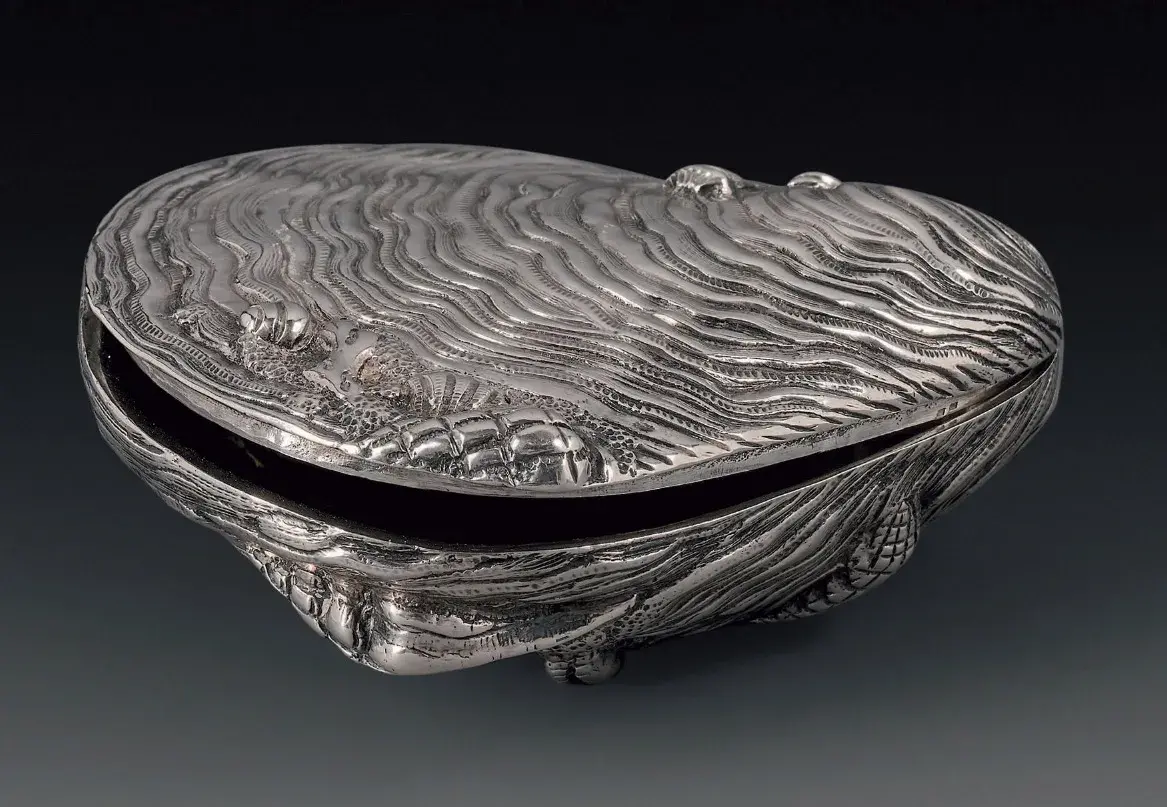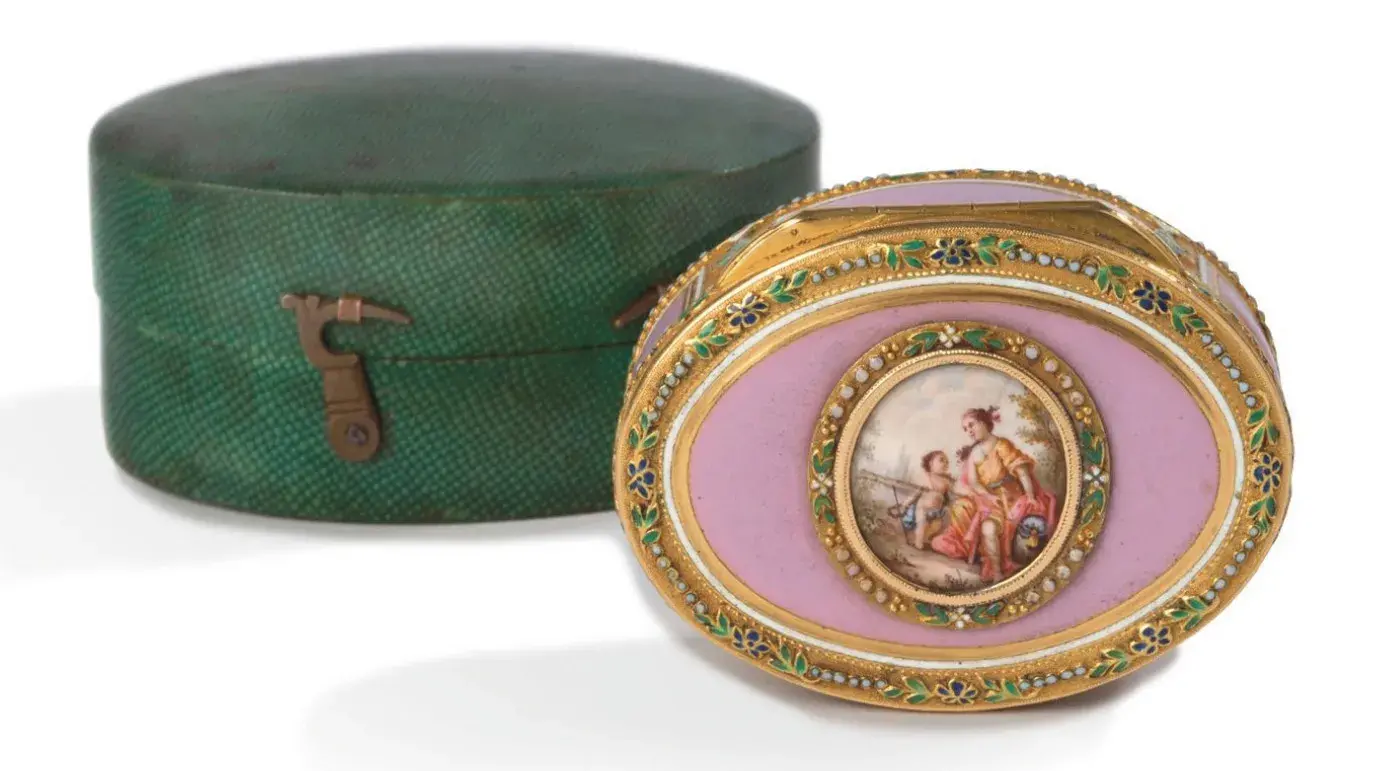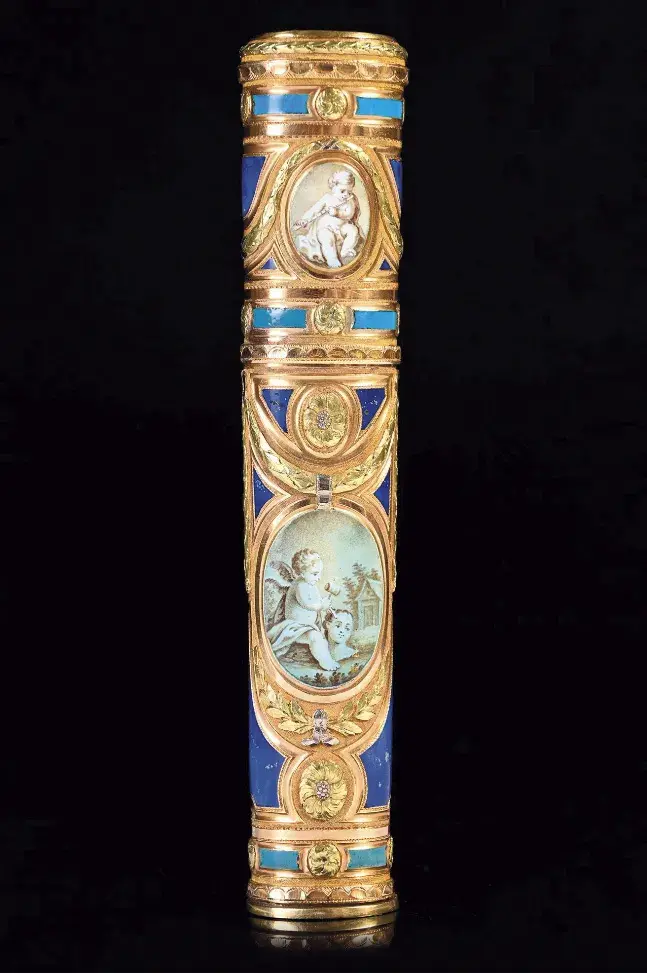Art Price Index: Luxury 18th-Century Pocket Boxes, a Reflection of Refined Social Customs
Illustrating the habits and customs of a refined and privileged society, exquisite small objects dating to and just after the Age of Enlightenment still arouse envy… and that’s no sin!

Sold for €347,760
The terms snuffbox, patch box, corsetière and wax case all belong to a vocabulary completely unknown to those younger than 200 years old! These objects recall a time when luxury was commonplace—at least for the very small segment of the nobly-born—and goldsmiths vied with each other in inventive ways to attract a clientele. These objects have come down through the centuries often intact, and are now keenly sought-after by collectors, as witnessed by their results at auction. The Musée Cognacq-Jay has now placed them in a striking, contextualized spotlight that provides much information on their individual purposes, making it an ideal time to examine them in detail.
Pocket-Sized Passions
While these small, exquisite objects are very much at home in the museum housing Ernest Cognacq’s collection, they also have a life of their own. The Age of Enlightenment was truly their era, when they inspired a craze, first in France, then throughout Europe. Very often made of gold and enriched with hardstones, precious gems, mother-of-pearl, porcelain, translucent enamels and sometimes miniatures, they had a variety of forms and uses that reflected the history of both art and fashion. At the time, these little pieces were known as “objects of virtue”—though virtue was hardly their chief attribute! In fact, the origin of this expression is somewhat obscure. According to the Musée Cognacq-Jay collection’s catalogue raisonné (published in 2011), it could be an Anglicism—Vertue being the name of a goldsmith or connoisseur—or harks back to the Protestants who emigrated from France when the Edict of Nantes was revoked. Those who refused to renounce their faith were called “the Virtuous”, and included many fine craftsmen, notably goldsmiths. These eminent specialists competed in ingenuity, creating real masterpieces full of imaginative touches and technical skill. Definitely worth noting in the exhibition is the carved agate dromedary doubling as a sweetmeat dish, the porcelain wax case in the shape of an asparagus and the miniature pistol disguising a perfume atomizer. Marvels can also be found at auction. Bernard Bellavoine, admitted as goldsmith c. 1738, made a silver snuffbox in Blois in around 1775 in the shape of a naturalistic flat oyster inlaid with seaweed and shells (€115,200, Drouot, March 29, 2022; Jean-Marc Delvaux Auction House.) What is even more astonishing is that, as well as their exquisite appearance, these items often had genuine domestic uses. Tobacco was popular in the 18th century. This herbaceous plant, which had arrived in ship holds a century earlier, was consumed in powder form, so needed impeccably airtight containers. Because everyone liked it, from the humblest peasants to the most elegant court ladies! The snuffbox, an object reflecting its owner’s wealth and good taste, thus became one of the most important specialties of goldwork, made only by goldsmith-jewelers. Its shape changed over the course of the 18th century, with the curved forms of its early years giving way, from c. 1740 onwards, to more sober rectangular lines that contrasted with the richness of its ornamentation. Designed with extreme refinement by master goldsmith Louis Urbain Thévenot in 1744-1745, a cage snuffbox, with engraved mother-of-pearl, coral and cornelian panels laid into a gold setting, garnered €175,000 at Fraysse & Associés in December 2015. Another from 1749—so modern for its time you might take it for an Art Nouveau piece, with its naturalistic decoration of a bouquet of narcissi in polychrome enamel—fetched €92,000 (December 1, 2017, Drouot, Beaussant Lefèvre & Associés). And on May 23, 2019, €67,600 went to a 1727 piece with the City of Amsterdam hallmark and a lid featuring a chased gold scene of the god Pan and shepherds (Neuilly-sur-Seine, Aguttes auction house).
Going Through a Good Patch
No gender theory in the 18th century? You might well ask…because if tobacco wasn’t just a male pastime, neither were “mouches” used only by women. These were small black silk or velvet patches or dots, subtle accessories designed for beauty and seduction that soon became indispensable to set off a white complexion. The position of these delicate ornaments was dictated by a precise code indicating the wearer’s mood and character. They all had their own names: “la passionnée”, indicating passion, was worn at the corner of the eye; “l’enjouée” on a dimple to convey playfulness; “la coquette”, signaling flirtatiousness, on the lips; “la gaillarde”, suggesting ribald impudence, on the nose; “la receleuse” to hide a pimple, and so on. Obviously, a suitable container was needed to store these charming treasures, which imitated facial moles and during the reign of Louis XV sported different shapes (stars, moons, suns and even animals). Enter the “mouche” or patch box! Like its predecessor, the snuffbox, the finest models were worked by jewelers rather than ordinary silversmiths. Also offered as wedding gifts, like snuffboxes, they might be embellished with stones, diamonds, enamel or miniatures. A small oval box plated in purple enamel on all sides, with an enameled medallion of a mythological scene on the lid, sold for €8,710 (Neuilly, December 6, 2023, Aguttes Auction House). These objects might be made in Martin varnish (€2,032 went to one produced in Paris between 1750 and 1752 with Japanese-style decoration, sold by Fraysse & Associés on April 7, 2022); horn (a Louis XVI box with gold decoration of a Chinese landscape on coral-lacquered powdered horn sold for €2,080 with Giquello in October 2022), mother-of-pearl veneered ivory, blonde tortoiseshell and sometimes composition.
A KEY FIGURE: 300
The number of snuffboxes—most of them sporting a profusion of precious stones—owned by Frederick II, King of Prussia and friend of the Enlightenment.

Sold for €106,250

Sold for €120,274



Sold for €328,980

October 14, 2022. Giquello auction house. Sold for €2,080


Singing Like a Bird!
Among all these creations, boxes featuring miniatures were the most common. In 2023, thanks to the “Tous mécènes!” campaign, with 5,000 donors contributing the €3.9M required, the Musée du Louvre bought an 18th-century masterpiece, the “Choiseul snuffbox” created by miniaturist Louis-Nicolas Van Blarenberghe and goldsmith Louis Roucel. All its sides have gouache views of interiors, including four of rooms in the Hôtel Choiseul-Richelieu. A charming model by Jean Ducrollay (a Parisian goldsmith and jeweler active between 1734 and 1761) adorned with polychrome panels painted with Boucher-style rural scenes went for €58,238 (December 2020, Fraysse & Associés). Alongside their French counterparts, highly active under Napoleon I (a keen consumer of these little wonders, ideal for publicizing his imperial likeness and those of his close circle), the Swiss became masters in their production from the early 19th century onwards. Between 1845 and 1850, Charles Magnin produced a gift snuffbox in gold and polychrome enamel with a portrait of Emperor Pedro II of Brazil (1825-1891), which fetched €48,100 with the R&C Auction House on January 30, 2024. The most spectacular boxes had additional assets like a “songbird” mechanism. The melodious song of a box-watch with enameling and pearls won it €328,980 with Aguttes in Neuilly on September 28, 2022. Its ingenious system is attributed to the Rochat brothers, who worked in the Vallée de Joux in the first half of the 19th century; we know they supplied parts to the company Jacquet-Droz & Leschot. We end this delightful stroll with the wax case, designed to house the substance (in stick or cake form, hence its elongated shape) used for sealing highly confidential letters. In 18th-century gold with simple guilloché work, one of these sells for around €2,000 (€2,035 went to a Louis XVI model with Beaussant Lefèvre & Associés, Drouot, on March 29, 2024) and can fetch up to ten times more, depending on its decoration and maker (a case with five polychrome enameled cartouches embellished with flowers, made in Paris in 1765 by Germain Chayé, went for €19,500 at Drouot on May 11, 2016 with Baron Ribeyre & Associés). The story goes that one François-Marie Arouet (Voltaire) was caught playing with his snuffbox at school. His rhetoric teacher confiscated it, promising to give it back if he made his request in verse. The young Voltaire wrote: “Farewell, my poor snuff-box; Farewell, I shall see thee no more; Neither care, nor tears, nor prayers shall make thee mine anew; My efforts are in vain. Farewell, sweet fruit of my savings! If money must buy thee back, I shall empty Plutus’ treasures.” The god of wealth need not fear the same from contemporary collectors…
WORTH SEEING
“Luxe de poche. Petits objets précieux au siècle des Lumières” (“Pocket-sized Luxury. Small precious objects in the Age of Enlightenment”), Musée Cognacq-Jay, Paris 3.
Until September 29, 2024
www.museecognacqjay.paris.fr









